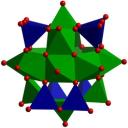Yahoo Answers is shutting down on May 4th, 2021 (Eastern Time) and beginning April 20th, 2021 (Eastern Time) the Yahoo Answers website will be in read-only mode. There will be no changes to other Yahoo properties or services, or your Yahoo account. You can find more information about the Yahoo Answers shutdown and how to download your data on this help page.
Trending News
Why are the only neutral group 6 hexahalides: SF6, SF5Cl, SeF6, TeF6, TeF5Cl, TeF5Br.?
My ideas were:
Group 16:
Increase in size down table therefore Oxygen is too small to fit 6 atoms around it (even F).
Po Lb have 6s inert pair so could only form tetra halides.
Halogens:
Most e-neg in their rows
F resists oxidation in hexahalide complexes by delocalising two electrons?
Anything else/more chemically correct?
1 Answer
- TimothyLv 68 years agoFavorite Answer
Nessie,
There are hexahalides of the group 6 (or 16) elements that are anions, TeBr₆²⁻ is a random example. So a steric argument isn't particularly convincing. Note that the neutral hexahalides must contain the group 6 element (the chalcogen, Ch) in the highest possible oxidation state for a chalcogen: +6. The high fluorine content of the compounds you have listed suggests that a powerful oxidant like fluorine is required to oxidize chalcogens up to the +6 oxidation state. Or, to put it another way, even if you managed to some how prepare a hexabromide or hexaiodide, it would be unstable with respect to loss of X₂: "ChX₆" → ChX₄ + X₂. Note that other stable +6 oxidation state chalcogen compounds are things like oxo compounds, oxoanions, or their conjugate acids, e.g., SO₃, SO₄²⁻ or H₂SO₄ - made by reaction with another strong oxidant: O₂.
Good luck in your inorganic chemistry course!
Source(s): inorganic chemistry professor




